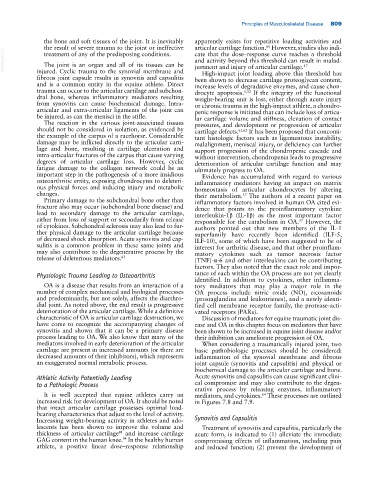Page 843 - Adams and Stashak's Lameness in Horses, 7th Edition
P. 843
Principles of Musculoskeletal Disease 809
the bone and soft tissues of the joint. It is inevitably apparently exists for repetitive loading activities and
60
the result of severe trauma to the joint or ineffective articular cartilage function. However, studies also indi
VetBooks.ir The joint is an organ and all of its tissues can be and activity beyond this threshold can result in malad
treatment of any of the predisposing conditions.
cate that the dose–response curve reaches a threshold
justment and injury of articular cartilage.
47
injured. Cyclic trauma to the synovial membrane and
High‐impact joint loading above this threshold has
fibrous joint capsule results in synovitis and capsulitis been shown to decrease cartilage proteoglycan content,
and is a common entity in the equine athlete. Direct increase levels of degradative enzymes, and cause chon
trauma can occur to the articular cartilage and subchon drocyte apoptosis. 1,52 If the integrity of the functional
dral bone, whereas inflammatory mediators resulting weight‐bearing unit is lost, either through acute injury
from synovitis can cause biochemical damage. Intra‐ or chronic trauma in the high‐impact athlete, a chondro
articular and extra‐articular ligaments of the joint can penic response is initiated that can include loss of articu
be injured, as can the menisci in the stifle. lar cartilage volume and stiffness, elevation of contact
The reaction in the various joint‐associated tissues pressures, and development or progression of articular
should not be considered in isolation, as evidenced by cartilage defects. 61,62 It has been proposed that concomi
the example of the carpus of a racehorse. Considerable tant histologic factors such as ligamentous instability,
damage may be inflicted directly to the articular carti malalignment, meniscal injury, or deficiency can further
lage and bone, resulting in cartilage ulceration and support progression of the chondropenic cascade and
intra‐articular fractures of the carpus that cause varying without intervention, chondropenia leads to progressive
degrees of articular cartilage loss. However, cyclic deterioration of articular cartilage function and may
fatigue damage to the collagen network could be an ultimately progress to OA.
important step in the pathogenesis of a more insidious Evidence has accumulated with regard to various
osteoarthritic entity, exposing chondrocytes to deleteri inflammatory mediators having an impact on matrix
ous physical forces and inducing injury and metabolic homeostasis of articular chondrocytes by altering
changes. their metabolism. The authors of a recent paper on
57
Primary damage to the subchondral bone other than inflammatory factors involved in human OA cited evi
fracture also may occur (subchondral bone disease) and dence that points to the proinflammatory cytokine
lead to secondary damage to the articular cartilage, interleukin‐1β (IL‐1β) as the most important factor
either from loss of support or secondarily from release responsible for the catabolism in OA. However, the
57
of cytokines. Subchondral sclerosis may also lead to fur authors pointed out that new members of the IL‐1
ther physical damage to the articular cartilage because superfamily have recently been identified (ILF‐5,
of decreased shock absorption. Acute synovitis and cap ILF‐10), some of which have been suggested to be of
sulitis is a common problem in these same joints and interest for arthritic disease, and that other proinflam
may also contribute to the degenerative process by the matory cytokines such as tumor necrosis factor
release of deleterious mediators. 63 (TNF)‐α‐6 and other interleukins can be contributing
factors. They also noted that the exact role and impor
Physiologic Trauma Leading to Osteoarthritis tance of each within the OA process are not yet clearly
identified. In addition to cytokines, other inflamma
OA is a disease that results from an interaction of a tory mediators that may play a major role in the
number of complex mechanical and biological processes OA process include nitric oxide (NO), eicosanoids
and predominantly, but not solely, affects the diarthro (prostaglandins and leukotrienes), and a newly identi
dial joint. As noted above, the end result is progressive fied cell membrane receptor family, the protease‐acti
deterioration of the articular cartilage. While a definitive vated receptors (PARs).
characteristic of OA is articular cartilage destruction, we Discussion of mediators for equine traumatic joint dis
have come to recognize the accompanying changes of ease and OA in this chapter focus on mediators that have
synovitis and shown that it can be a primary disease been shown to be increased in equine joint disease and/or
process leading to OA. We also know that many of the their inhibition can ameliorate progression of OA.
mediators involved in early deterioration of the articular When considering a traumatically injured joint, two
cartilage are present in increased amounts (or there are basic pathobiologic processes should be considered:
decreased amounts of their inhibitors), which represents inflammation of the synovial membrane and fibrous
an exaggerated normal metabolic process. joint capsule (synovitis and capsulitis) and physical or
biochemical damage to the articular cartilage and bone.
Athletic Activity Potentially Leading Acute synovitis and capsulitis can cause significant clini
to a Pathologic Process cal compromise and may also contribute to the degen
erative process by releasing enzymes, inflammatory
It is well accepted that equine athletes carry an mediators, and cytokines. These processes are outlined
64
increased risk for development of OA. It should be noted in Figures 7.8 and 7.9.
that intact articular cartilage possesses optimal load‐
bearing characteristics that adjust to the level of activity.
Increasing weight‐bearing activity in athletes and ado Synovitis and Capsulitis
lescents has been shown to improve the volume and Treatment of synovitis and capsulitis, particularly the
thickness of articular cartilage and increase cartilage acute form, is indicated to (1) alleviate the immediate
41
GAG content in the human knee. In the healthy human compromising effects of inflammation, including pain
94
athlete, a positive linear dose–response relationship and reduced function; (2) prevent the development of

